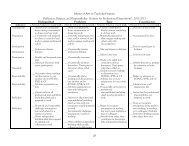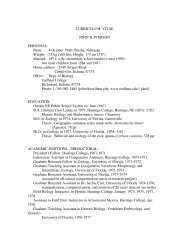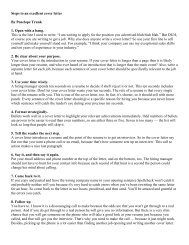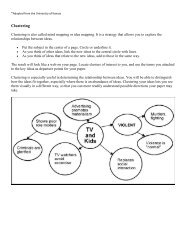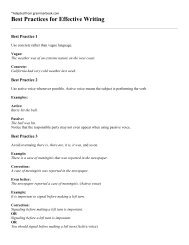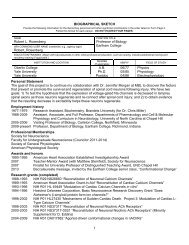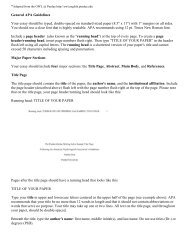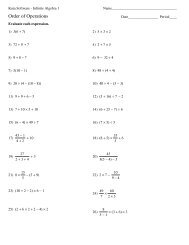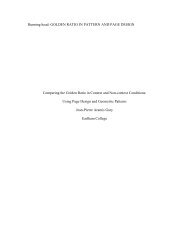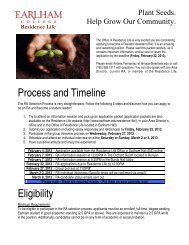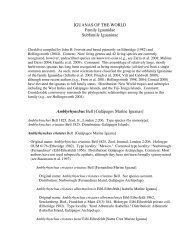Earlham College, Richmond, IN - Earlham Computer Science ...
Earlham College, Richmond, IN - Earlham Computer Science ...
Earlham College, Richmond, IN - Earlham Computer Science ...
Create successful ePaper yourself
Turn your PDF publications into a flip-book with our unique Google optimized e-Paper software.
URPC Proceedings<br />
The Effects of Ultraviolet and Visible Spectrum Coloration on Predation<br />
Risk of Lepidopteran Larvae<br />
Phoebe C. Hallowell<br />
<strong>Earlham</strong> <strong>College</strong> Biology Department<br />
pchallo07@earlham.edu<br />
Lepidopteran larvae are known to use cryptic and protective colorations as adaptations<br />
to avoid detection by predators. There has been a lot of research on the role of coloration<br />
within visual spectrum; however some predators, such as birds as well as many insects, can<br />
see ultraviolet (UV) coloration and this may be a factor when predators are foraging. In this<br />
study I tested whether or not predators of Lepidoptera larvae use UV signals in detecting<br />
and selecting their prey. I hypothesized that predators use both visible and UV coloration<br />
cues when foraging. I predicted that caterpillars with UV markings would incur in more<br />
predator damage than plain caterpillars and caterpillars that are of the opposite color of the<br />
substrate (e.g. green caterpillar in brown substrate) will have more damage than those of<br />
the same color. To test this hypothesis, I conducted a field experiment with 4 different clay<br />
caterpillar type options (Brown No UV, Brown UV, Green No UV, and Green UV) on either<br />
a green or brown substrate in a rainforest edge in south eastern Peru.. After 48 hours, they<br />
were collected and I determined if the caterpillars were untouched, mildly damaged by a<br />
predator (i.e.,a few insect markings) or severely damaged by a predator (e.g. bill or teeth<br />
marks or having been completely removed from the immediate area). My results suggest<br />
that predators use cues from both the visual and ultraviolet spectra in locating and selecting<br />
their prey. I found that caterpillars with UV colorations and caterpillars with visible spectrum<br />
coloration opposite to that of the substrate had higher predation rates. Thus, visual<br />
and ultraviolet coloration play an important role in the survival of Lepidopteran larvae.<br />
Identification of Basaltic Clasts in Lunar Meteorites: In Search of South<br />
Pole-Aitken Basin Material<br />
Katie Marshall, Cari Corrigan †<br />
Smithsonian Institution National Museum of Natural History<br />
kjmarsh07@earlham.edu<br />
The South Pole-Aitken Basin (SPA), located on the far side of the Moon in the Southern<br />
Hemisphere, is the largest (250 km), deepest (8-12 km), and oldest ( 4Ga) basin on the<br />
Moon. Due to its great depth, the SPA Basin may expose the lower crust and even the<br />
mantle of the Moon. In order to find SPA Basin material, lunar meteorite thin sections in the<br />
Smithsonian Institutions Antarctic Meteorite Collection were analyzed for basaltic clasts.<br />
These clasts were located by the component minerals plagioclase feldspar, olivine, and<br />
pyroxene, using an optical microscope, an electron scanning microscope, and a microprobe.<br />
In six of the lunar meteorite thin sections a total of seventeen basaltic clasts were located.<br />
These clasts will undergo future tests, including Ar-Ar age dating and analysis for rare<br />
earth elements, to determine if they are South Pole-Aitken Basin material.<br />
URPC-12



